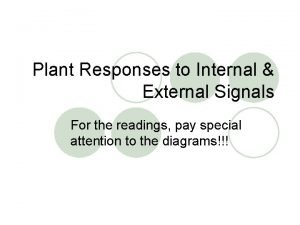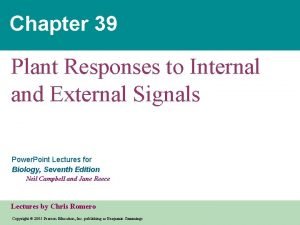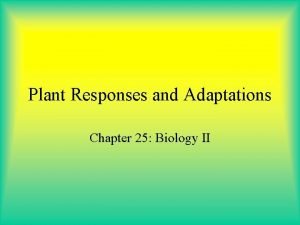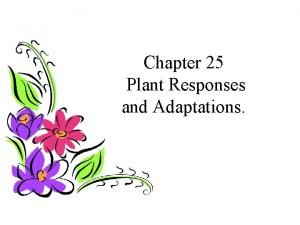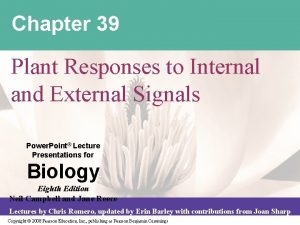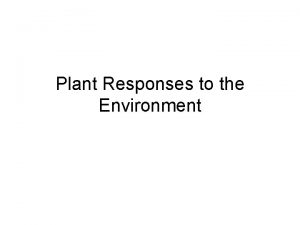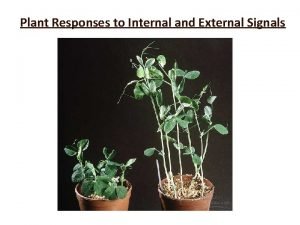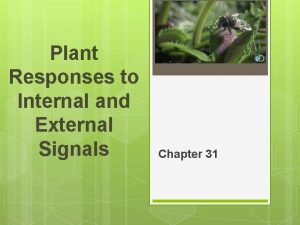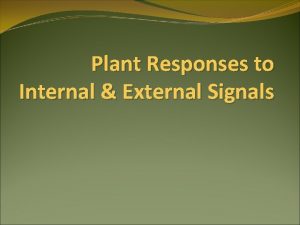Powerpoint Templates Plant Responses to Internal External Signals
















- Slides: 16

Powerpoint Templates Plant Responses to Internal & External Signals CHAPTER 39 Page 1

Tropism Powerpoint Templates • A plant growth response from hormones that results in the plant growing either toward or away from a stimulus • Hormones – chemical messengers that coordinate the different parts of a multicellular organism Page 2

Powerpoint Templates • Types of tropisms: • Phototropism – growth toward or away from light • Gravitropism – growth toward or away from a gravitational source • Thigmotropism – growth toward or away from a touch – Vines grow toward a support and then grow toward (around) that support Page 3

Positive vs. Negative Tropisms Powerpoint Templates • Positive is growth toward a stimulus • Positive Phototropism – growth toward light • Positive Gravitropism – growth toward a gravitational source • Positive Thigmotropism – growth toward a tactile stimulus • Negative is growth away from a stimulus Page 4

Hormones Powerpoint Templates • Auxins • Stimulate cell elongation » Cause proton pumps to activate Lower p. H weakening of cell wall turgor pressure expands & elongates cell wall • High concentrations of synthetic auxins KILL certain plants, usually weeds (eudicots) • Synthetically produced auxins in high Page 5 concentration = Herbicides

How do. Powerpoint you. Templates make a …? • Cytokinins • Stimulate cell division or cytokinesis • Proper ratio of auxins & cytokinins cell division & differentiation • Gibberellins • Work with auxins to stimulate stem elongation • Loosen cell walls allowing cellular expansion stem expansion • Signal the seed to cease dormancy and germinate • Many dwarf plant varieties have non-functional gibberellins Page 6

Hormones (Page 3) Powerpoint Templates • Abscisic acid • SLOWS Growth • Antagonistic to previously mentioned hormones » Promotes seed dormancy, but gibberellins cease it • Causes stomata to close to conserve water Page 7

Powerpoint Templates • Ethylene • Gas • Plays crucial role in programmed cell death (apoptosis) • Promotes ripening of fruit • Ripening in one fruit ripening in other fruits » Positive feedback mechanism = rapid ripening of fruit » One bad apple does spoil the lot. Page 8

Plants. Powerpoint respond to Light Templates • Plants can detect presence, direction, intensity, and wavelength of light • Red & Blue wavelengths are most important • Blue light is most important for phototropisms and light-induced opening of stomata • Sensed by photoreceptors Page 9

Phytochromes Powerpoint Templates • Photoreceptors for red light (mainly) • Exist in 2 isomer forms which can switch forms depending on wavelength available • Responsible for Circadian Rhythms • 24 hour cycles Page 10

Photoperiodism Powerpoint Templates • Physiological response to a photoperiod (relative lengths of day and night) • Night is always the more important of the 2!! • But we (humans) focus on the daylight. • Controls Flowering • Short-day plants • Require a period of continuous darkness exceeding a critical measure in order to flower • Early Spring or Fall flowering • Sometimes called “Long-Night” plants Page 11

Besides. Powerpoint Short-Day plants, Templates • Long-Day Plants • Flower only if a period of continuous darkness is less than a critical value • Flower in Late Spring or early Summer • Considered “short-night” plants • Day-Neutral Plants • No length of continual darkness is needed for flowering Page 12

Plants respond to things other than Powerpoint Templates light • Gravitropism – growth toward the earth (gravity) • Auxin plays key role • If root is plased horizontally, then gravity causes an accumulation of auxins in root’s lower side • Remember HIGH auxin = inhibition of growth at high concentration, so » lower side = no growth » Upper side = growth » Allows the root to grow down into the ground Page 13

Auxin Accumulation Powerpoint Templates Page 14

Plants respond to other things… Powerpoint Templates • Drought • • Stomata close Leaves will cease growth Leaves roll into shape that reduces transpiration Deep roots (where H 2 O is) will speed their growth, but shallow roots will stop growing • Predators • Thorns, chemicals, distasteful compounds • Some plants even attract parasites • First layer of defense - Epidermis Page 15

Coordinated Plant-Parasite Powerpoint Templates Defense Page 16
 Plant responses to internal and external signals
Plant responses to internal and external signals Seed germination
Seed germination Communicative signals and informative signals
Communicative signals and informative signals Arbitrariness in human language and animal language
Arbitrariness in human language and animal language Communicative and informative signals
Communicative and informative signals Chapter 25 plant responses and adaptations
Chapter 25 plant responses and adaptations Chapter 25 plant responses and adaptations
Chapter 25 plant responses and adaptations Respond to
Respond to Plant hormones and responses
Plant hormones and responses The stationary life
The stationary life Powerpoim
Powerpoim Allppt.com template
Allppt.com template Allppt template
Allppt template Islamic background ppt
Islamic background ppt Www.brainybetty.com
Www.brainybetty.com Free elearning templates for powerpoint
Free elearning templates for powerpoint Allppt.com.
Allppt.com.
